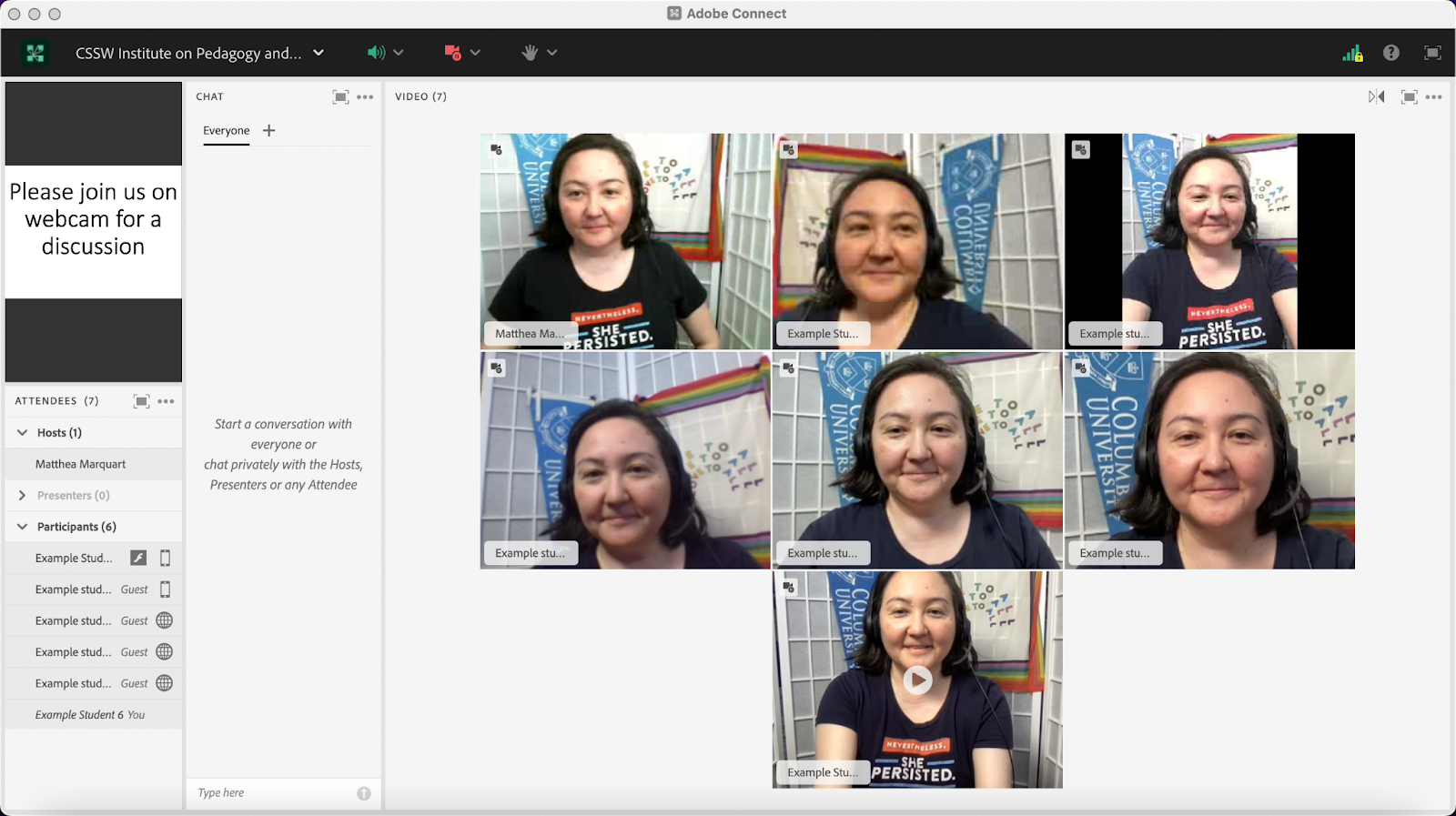At times, instructors may want to bring all students onto webcam together. This chapter demonstrates an example of what this might look like.
Teaching and Learning Goal
In general, I do not ask students to be on webcam throughout a full class session, for reasons of equity, privacy, cognitive load, webcam fatigue, and attention to learning (Marquart & Russell, 2020; Marquart et al, 2021; Marquart et al, 2022). However, some classroom activities can benefit from having everyone on webcam together. In those cases, the goals of having everyone on webcam can include:
- Building community.
- Facilitating a discussion in which everyone can see each other
Activity and Results
Activities that can benefit from having everyone on webcam together include:
- Some whole-class discussions can benefit from students being able to see each other.
- Before going into breakout group activities, it can be helpful to briefly bring everyone onto webcam together so that when the class transitions into breakout groups, everyone’s ready to begin talking together. This can minimize the transition time before starting the small-group activity.
- Saying hello and chatting before class begins, during breaks, or after class ends. It can build community to get to know each other informally.
- Taking a class photo together on the last day of class, for those who would like to do this as an optional goodbye activity. When doing this, it’s important to first agree as a class about how and where the photo can be shared. For example, the class may agree that the photo can or cannot be shared on social media.
In addition, some activities can use a similar layout but only entail bringing some of the students in the class onto webcam together, rather than all of the students. Activities that can benefit from having part of the class on webcam together include:
- Role play activities
- Fishbowl activities
- Panel discussions
- Breakout activity report-backs
- Debates
Technical Details and Steps
To bring the class onto webcam together, I created a classroom layout with a large Video pod (see Image 1). I made the Chat pod tall and narrow, so that many chat comments can be visible at once. This makes it easier to read the chat conversation than it would be to read it on a short and wide Chat pod where only a few chat comments can be visible at a time. I put the Chat pod on the left, so that the Chat is near the instructions and Attendees pod and all the text in the room is grouped together, with the rest of the layout dedicated to webcams.
What this looked like in Adobe Connect
Image 1. Example Adobe Connect layout with a large Video pod to demonstrate what this can look like. The screengrab was captured by the author while logging into the room using multiple Internet browsers and devices. As a note, many more webcams can be shown together in an Adobe Connect room, but the author ran out of devices to be able to include more webcam images in this screengrab. Adobe product screenshot(s) reprinted with permission from Adobe.
Image 1 Alt-Text. This is a screengrab of an Adobe Connect classroom layout designed to prioritize participation on webcam. On the far right side, there is a small Share pod showing a slide with the following instructions: “Please join us on webcam for a discussion.” Below that is a narrow Attendees pod. Next, there is a narrow Chat pod stretching from the top to the bottom of the layout. The rest of the layout is one large Video pod that takes up about 75% of the layout. In the Video pod, there are 7 webcams, all showing the author of this chapter.

References
Marquart, M., Marshall, L.W., Chung, R.Y., Garay, K., & the Columbia University School of Social Work’s Online Campus Community. (2022, March 29). Anti-racist pedagogical considerations and strategies for synchronous online courses. Poster for the Columbia University Center for Teaching and Learning’s Celebration of Teaching and Learning Symposium, New York, NY. https://edtechbooks.org/-crKY
Marquart, M. & Russell, L.R. (2020, September 10). Dear Professors: Don’t let student webcams trick you: Instructors who teach live online classes should thoughtfully consider whether to require students to use their webcams during class. EDUCAUSE Transforming Higher Ed Blog. https://edtechbooks.org/-eCNQ
Marquart, M., Shedrick, D., and Ortega, A. (2021, February 25). A conversation about anti-racist approaches to student webcam requirements in online courses. Roundtable discussion for the 38th Winter Roundtable Conference: A Pandemic of Racism, Teacher’s College, Columbia University. Online via Zoom. https://edtechbooks.org/-UuYx